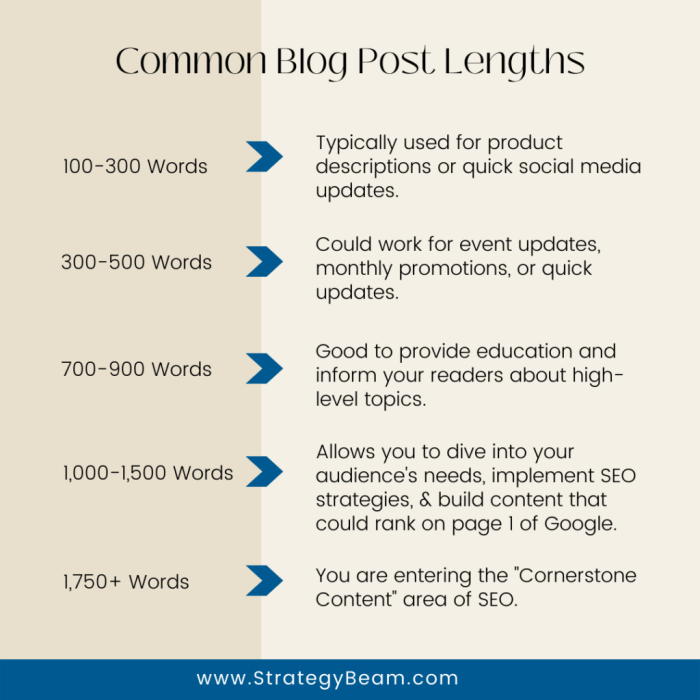How long should a blog post be? This question is crucial for bloggers aiming to engage readers and achieve success. Different post types, like listicles or how-to guides, have varying optimal lengths. Understanding these nuances is key to crafting compelling content that resonates with your audience and boosts your online presence.
This exploration delves into the factors influencing blog post length, from target audience and topic depth to the impact on readability and . We’ll analyze successful examples, provide strategies for optimization, and show you how to measure post effectiveness. Get ready to unlock the secrets of crafting blog posts that captivate readers and climb the search engine rankings!
Defining Blog Post Length

Blog posts, like any form of writing, benefit from a well-considered structure and length. A carefully chosen length directly impacts reader engagement and the overall effectiveness of conveying information. Knowing the typical length for various blog post types allows you to optimize content for maximum impact.Understanding the relationship between blog post length and reader engagement is crucial. Shorter posts are often better for quick tips or breaking news, while longer posts can delve deeper into complex topics, allowing for a more thorough exploration of a subject and creating a more immersive reading experience.
Blog Post Types and Length Expectations
Different blog post types typically have varying length expectations. These expectations are influenced by the complexity of the topic, the depth of the content, and the overall purpose of the post.
- Listicles: Listicles, characterized by numbered or bulleted lists, are often shorter and more easily digestible. A good rule of thumb for listicle posts is 500-1500 words, with 700-1000 words being a common sweet spot. They usually focus on a specific theme or topic, providing a concise overview of various aspects or elements. The shorter length is designed to maintain reader interest and encourage quick consumption of information.
An example might be a list of “Top 10 Tips for Productivity,” or “5 Mistakes to Avoid When Starting a Blog.”
- How-to Guides: How-to guides, designed to walk readers through a process, can vary significantly in length. The complexity of the task directly influences the length, with more intricate processes requiring longer explanations. These posts generally range from 800 to 3000 words. A longer length allows for detailed instructions, illustrative examples, and troubleshooting steps. An example might be “How to Write a Compelling Blog Post” or “How to Fix a Leaky Faucet.”
- Opinion Pieces: Opinion pieces, presenting personal perspectives and arguments, often fall between 500 and 1500 words. The length allows for a robust discussion of a topic while maintaining a focused, conversational tone. These posts encourage engagement and offer a platform for diverse viewpoints. An example might be “Why I Think the Latest Tech Trend is a Flop” or “My Thoughts on the Future of Education.”
Correlation Between Length and Reader Engagement
The length of a blog post directly correlates with the level of engagement a reader can experience. A shorter post might encourage quick reading and immediate application of the information. A longer post allows for a more comprehensive exploration of a topic, fostering a deeper understanding and potentially encouraging more in-depth engagement. The level of engagement often depends on the reader’s interest in the subject matter and their willingness to dedicate time to a longer piece.
Optimal Length Ranges for Different Blog Post Types
The table below provides a general guideline for optimal length ranges for different blog post types, considering the reader’s engagement and the complexity of the content.
| Blog Post Type | Optimal Length Range (Words) |
|---|---|
| Listicles | 500-1500 |
| How-to Guides | 800-3000 |
| Opinion Pieces | 500-1500 |
Factors Influencing Blog Post Length
Blog posts, like any form of writing, aren’t one-size-fits-all. The ideal length depends on a variety of factors, from the specific topic to the target audience’s attention span. Understanding these influencing factors helps writers craft engaging and effective content that resonates with readers.Different topics and purposes demand varying lengths. A simple “how-to” post might be concise, while a comprehensive analysis of a complex issue will naturally be longer.
This flexibility is crucial for delivering valuable information in a format that keeps readers engaged and satisfies their information needs.
Figuring out the ideal blog post length is tricky, but it’s definitely impacted by current trends. With the rise of AI and its potential to disrupt traditional web business models, like the one discussed in this insightful piece on ai killing web business model , blog posts need to be engaging and informative to stand out. Ultimately, quality over quantity still reigns supreme, so focus on providing value rather than just hitting a specific word count.
Target Audience and Topic Depth
Understanding your target audience is paramount. Younger audiences, for instance, might have shorter attention spans compared to those with more extensive experience in a specific area. If your audience is new to a topic, a more concise and introductory approach might be more effective. Conversely, for seasoned professionals seeking in-depth analysis, a longer post providing comprehensive insights will likely be appreciated.
The complexity of the topic directly impacts length. Explaining a simple concept needs fewer words, whereas exploring multifaceted issues demands a longer format to provide adequate coverage.
Reader Attention Spans and Optimal Post Length
Reader attention spans are a significant consideration. Studies consistently show that attention spans are relatively short, especially online. However, this doesn’t mean all posts should be extremely brief. Engagement and value still play a vital role. A well-structured, engaging post, even if longer, can maintain reader interest if the information is presented in digestible chunks, such as through clear headings, subheadings, bullet points, and visuals.
Figuring out the ideal blog post length is tricky, but it’s not just about word count. Sometimes a concise, well-structured post can be more impactful than a rambling one. For example, learning from successful social media campaigns like those highlighted in the best social media campaigns can offer insights. Ultimately, the best length depends on the topic and your target audience.
Keep your content focused and engaging to maximize reader interest, regardless of the word count.
Posts that effectively break down complex information into easily understandable segments are likely to keep readers engaged for longer periods.
Content Format and Suggested Length
Different content formats inherently influence the ideal length of a blog post. For example, a post filled with step-by-step instructions, like a recipe or a DIY guide, could be shorter than a comprehensive analysis of a specific topic. Conversely, a comprehensive guide might need more space to cover all aspects of a given subject. A post that utilizes images, infographics, and videos will typically be shorter, as these visual aids help break up text and maintain reader interest.
A long-form article on a topic like marketing strategies might be more detailed, and thus longer, while a post focusing on a quick tip could be much shorter.
| Content Format | Suggested Length (Approximate) | Rationale |
|---|---|---|
| How-to guide | 500-1000 words | Clear steps, concise explanations |
| Product review | 300-500 words | Focused analysis, brief description |
| Industry analysis | 1500-2000+ words | In-depth exploration, diverse perspectives |
| Listicles | 500-1500 words | Compelling points, digestible chunks |
| Case study | 1000-2000+ words | Detailed example, data-driven analysis |
Impact of Length on Readability and

Blog post length significantly impacts both reader engagement and search engine optimization (). A well-crafted post, regardless of length, prioritizes clarity and value. The ideal length, as we’ve explored, depends on the topic and target audience. However, understanding the interplay between length, readability, and is crucial for optimizing content for both humans and search engines.A carefully considered approach to structuring long-form content, balancing depth and engagement, can translate into a more satisfying experience for readers and a higher ranking for the blog post.
Reader Comprehension and Engagement
Reader comprehension and engagement are directly tied to the length and structure of a blog post. Short, concise posts can be highly effective for quick information or updates, but longer pieces offer more in-depth analysis and exploration of complex subjects. Maintaining reader interest in longer posts requires strategic structuring and clear transitions between ideas. Employing headings, subheadings, bullet points, and visuals enhances readability, breaks up text, and allows readers to quickly grasp key takeaways.
Readability of Short vs. Long-Form Posts
Short-form posts excel at conveying quick updates or simple concepts. They are easily digestible and perfect for capturing immediate attention. However, their limited space restricts in-depth exploration and analysis. Conversely, long-form posts provide opportunities for comprehensive discussions, supporting arguments with evidence and examples, ultimately leading to a more insightful and engaging experience for readers. The readability of both types depends heavily on writing style, clarity, and appropriate use of formatting.
Impact on Factors
Blog post length influences factors like density, dwell time, and backlinks. Longer posts often have a higher word count, potentially allowing for more relevant s and a broader exploration of a topic. This can improve search engine ranking, as search engines may perceive a more comprehensive and authoritative approach. However, excessively long posts without clear structure can be detrimental.
Well-structured long-form content can significantly improve dwell time, which search engines interpret as a positive signal of user engagement.
Structuring a Long-Form Post for Readability
Maintaining readability in long-form content requires a thoughtful approach to structure. Employing a clear, logical structure, incorporating headings and subheadings, and using visuals, like images or videos, can make the post more scannable and accessible. Consistent use of bullet points and numbered lists further enhances the ease of reading and understanding.
Figuring out the ideal blog post length can be tricky, but it’s not just about word count. A compelling piece needs to deliver value, and sometimes that means a shorter post is perfectly fine. For instance, if you’re aiming to boost your email open rate, a shorter, snappy post can actually be more effective at grabbing attention and driving conversions.
A longer post can sometimes lose focus, but it depends on the topic. Ultimately, the ideal length depends on your target audience and the specific message you want to convey, just like finding the right formula for improve email open rate. So, don’t be afraid to experiment and see what resonates best with your readers.
- Use Headings and Subheadings: Breaking up large blocks of text with clear headings and subheadings allows readers to quickly scan the content and locate the specific information they need.
- Incorporate Visuals: Images, infographics, and videos can break up text, add visual interest, and make complex information easier to understand.
- Employ Lists: Bullet points and numbered lists improve readability and allow readers to quickly absorb key takeaways.
- Maintain a Conversational Tone: Writing in a conversational and engaging style can make the content more approachable and less intimidating for readers.
By focusing on clarity, structure, and visual appeal, long-form posts can be highly effective in engaging readers and boosting performance. The balance between length and readability is essential for optimizing content for both humans and search engines.
Strategies for Optimizing Blog Post Length
Crafting the perfect blog post length isn’t about hitting a magic number; it’s about aligning the content’s depth with the reader’s needs and the topic’s complexity. This involves careful consideration of the information’s density, the reader’s engagement, and the desired impact. A well-structured post, regardless of length, can achieve its goals.Optimizing blog post length is a strategic process, not a rigid rule.
Understanding your audience and the nuances of your topic allows you to create a post that is both informative and engaging, maximizing its impact without overwhelming readers. Determining the ideal length is a crucial aspect of this optimization.
Determining Ideal Length
Understanding your audience and the topic’s complexity is key to determining the ideal length. A post addressing a highly specialized subject might require more in-depth exploration, leading to a longer format, while a simpler topic could be effectively covered in a shorter piece. Consider the following factors when determining the optimal length for your blog post:
- Audience familiarity with the topic: A beginner-level guide to a new technology will need more introductory material than a post targeted at experienced users. For instance, a comprehensive guide on using a new social media platform for beginners would need more context and explanations than a post focused on advanced features for experienced users.
- Information density: Highly detailed topics necessitate more space for explanation. If your post delves into intricate technical details, a longer format will be more effective. For example, a post on the intricacies of quantum physics would require a larger space than a post on the basics of everyday physics.
- Desired impact: A post aiming for a deep dive into a subject might be longer, while a post designed for quick takeaways might be shorter. A post on improving customer service would benefit from a more detailed explanation, while a post on the best ways to find a job might need a more concise approach.
Breaking Down Complex Topics
Complex topics can be overwhelming for readers. Strategic segmentation of information into digestible chunks improves comprehension and engagement. This involves using headings, subheadings, and bullet points. A well-structured layout, with clearly defined sections, ensures the reader doesn’t get lost in the information.
- Headings and Subheadings: Employ a hierarchical structure with headings (H1, H2, H3) to create logical sections within your post. This visual hierarchy aids readability and allows readers to quickly scan and locate specific information. For example, a post on investing would benefit from headings like “Understanding Stock Markets,” “Different Investment Strategies,” and “Risk Management.”
- Bullet Points: Use bullet points to list key takeaways, steps in a process, or important details. Bullet points increase readability and make information easier to absorb. For example, a post on creating a presentation would use bullet points to list the key steps in the process.
- Visual Aids: Visual aids, such as charts, graphs, or images, can effectively break up text and make complex information more accessible. Visuals can also enhance understanding and engagement.
Using Headings, Subheadings, and Bullet Points
These elements significantly improve readability and . Employing a clear hierarchy of headings (H1, H2, H3) and using subheadings creates a logical structure, helping readers scan and locate specific information. Bullet points enhance the readability of lists, steps, or important points.
- Hierarchical Structure: A hierarchical structure with headings creates logical sections. This allows readers to quickly scan and locate specific information. For instance, a post on time management should have headings like “Planning Your Day,” “Prioritizing Tasks,” and “Managing Distractions.”
- Visual Hierarchy: Headings and subheadings establish a clear visual hierarchy, making the post scannable and digestible. This improves reader experience, particularly for those who prefer to skim content. For instance, a post on budgeting should have headings like “Creating a Budget,” “Tracking Expenses,” and “Saving Strategies.”
- Emphasis and Clarity: Headings and subheadings provide emphasis, enhancing the clarity of the content. For instance, a post on social media marketing would use headings like “Creating Engaging Content,” “Building a Community,” and “Analyzing Performance.”
Table: Strategies for Optimizing Different Blog Post Types
| Blog Post Type | Ideal Length Range (approx.) | Strategies for Optimization |
|---|---|---|
| Beginner’s Guide | 1000-1500 words | Use clear, concise language; break down complex topics into smaller sections; include visuals; focus on easy-to-understand explanations. |
| In-depth Analysis | 1500-3000+ words | Employ a structured approach; use multiple headings and subheadings; support claims with evidence; provide a comprehensive overview. |
| How-to Guide | 500-1500 words | Focus on clear steps; use visuals where applicable; provide examples; ensure logical flow. |
| News/Update | 300-800 words | Maintain brevity; highlight key points; use strong headlines; provide context; include links to further information. |
Measuring Blog Post Success: How Long Should A Blog Post Be
Knowing how your blog posts perform is crucial for optimizing content strategy. This isn’t just about counting page views; it’s about understanding what resonates with your audience and tailoring your future posts to better meet their needs. Effective measurement helps you identify what works and what doesn’t, allowing for continuous improvement and increased engagement.Understanding reader interaction is key to determining if your blog post length strategies are effective.
Metrics like time on page, bounce rate, and comments reveal valuable insights into how readers engage with different post lengths. By analyzing this data, you can adjust your future content strategy to optimize for better engagement and reach your target audience more effectively.
Key Metrics for Assessing Blog Post Performance
Analyzing reader engagement is essential to evaluating the effectiveness of blog posts of varying lengths. This involves looking at key metrics that reflect how readers interact with your content. These metrics provide a comprehensive view of the post’s performance, revealing valuable insights for future content creation.
- Time on Page: This metric measures the average time visitors spend on a specific blog post. Longer time on page generally indicates that the content is engaging and valuable to the reader. A longer post might naturally lead to more time spent, but this doesn’t guarantee higher engagement. Engagement is more complex, and simply longer time spent might not mean a better post.
- Bounce Rate: This represents the percentage of visitors who leave your website after viewing only one page (in this case, the blog post). A high bounce rate might suggest the post’s introduction or content doesn’t capture the reader’s attention, or that the post isn’t relevant to what they were searching for. A longer, more in-depth post might have a lower bounce rate if it successfully answers the user’s query.
- Comments and Social Shares: These metrics provide direct feedback on reader engagement and interest in the post. A blog post that generates many comments or social shares indicates a higher level of engagement, suggesting that the content is compelling and encourages interaction. Longer posts often allow for more in-depth discussions, which could lead to more comments and shares.
- Conversion Rates (If Applicable): If your blog posts are designed to drive specific actions (like signing up for a newsletter or making a purchase), monitoring conversion rates associated with each post length can reveal insights. A longer post might result in a higher conversion rate if it provides more detailed information that convinces readers to take the desired action.
Tracking and Analyzing Reader Engagement
To gain meaningful insights into reader engagement with your blog posts, implementing robust tracking and analysis methods is crucial. Utilizing website analytics tools allows you to gather comprehensive data about user behavior on your site.
- Using Analytics Tools: Utilize website analytics platforms (like Google Analytics) to monitor the metrics mentioned above. This allows for a detailed analysis of how different post lengths affect reader engagement.
- Segmenting Data: Segment your data based on post length. This helps to isolate the performance of different post length categories, enabling a precise comparison of how each performs. For example, compare the time spent on posts under 500 words versus those over 1500 words.
- Identifying Patterns: Look for patterns in the data. Are longer posts consistently performing better in terms of time on page, or do shorter posts achieve higher engagement rates in other metrics? Understanding these patterns is crucial for informed decision-making about post length.
Incorporating Data into Future Post Length Decisions
Data analysis allows you to make data-driven decisions about blog post length. By examining the performance of your posts, you can tailor your content strategy to achieve optimal engagement.
- Correlation Analysis: Analyze the correlation between post length and engagement metrics. For example, if longer posts consistently result in higher time-on-page, this suggests a positive correlation, and you can continue focusing on longer-form content.
- A/B Testing: Conduct A/B testing to compare the performance of different post lengths. This allows you to systematically test different approaches and see which one performs best for your audience.
- Iterative Optimization: Adjust your content strategy iteratively based on the data you gather. Use the insights to refine your approach to post length and overall content strategy.
Example Metrics Analysis Table, How long should a blog post be
| Metric | Short Post (Under 500 words) | Medium Post (500-1000 words) | Long Post (Over 1000 words) |
|---|---|---|---|
| Average Time on Page | 2 minutes | 5 minutes | 8 minutes |
| Bounce Rate | 15% | 10% | 8% |
| Comments/Shares | 2 | 5 | 10 |
Ending Remarks
In conclusion, the ideal blog post length isn’t a one-size-fits-all answer. It depends on the specific post type, target audience, and content complexity. By understanding these factors and implementing the optimization strategies Artikeld, you can create engaging, readable, and -friendly blog posts that drive reader interaction and achieve your goals. Ultimately, the key is to focus on delivering value to your audience while considering how the length of your posts impacts their experience.








